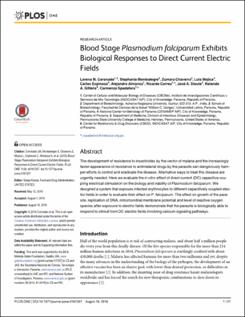| dc.contributor.author | Coronado, Lorena M. | |
| dc.contributor.author | Montealegre, Stephania | |
| dc.contributor.author | Chaverra, Zumara | |
| dc.contributor.author | Mojica, Luis | |
| dc.contributor.author | Espinosa, Carlos | |
| dc.contributor.author | Almanza, Alejandro | |
| dc.contributor.author | Correa, Ricardo | |
| dc.contributor.author | Stoute, José A. | |
| dc.contributor.author | Gittens, Rolando A. | |
| dc.contributor.author | Spadafora, Carmenza | |
| dc.date.accessioned | 2020-06-24T17:32:29Z | |
| dc.date.available | 2020-06-24T17:32:29Z | |
| dc.date.issued | 2016-08-18 | |
| dc.identifier.other | 10.1371/journal.pone.0161207 | |
| dc.identifier.uri | http://repositorio-indicasat.org.pa/handle/123456789/108 | |
| dc.description | The development of resistance to insecticides by the vector of malaria and the increasingly faster appearance of resistance to antimalarial drugs by the parasite can dangerously hamper efforts to control and eradicate the disease. Alternative ways to treat this disease are urgently needed. Here we evaluate the in vitro effect of direct current (DC) capacitive coupling electrical stimulation on the biology and viability of Plasmodium falciparum. We designed a system that exposes infected erythrocytes to different capacitively coupled electric fields in order to evaluate their effect on P. falciparum. The effect on growth of the parasite, replication of DNA, mitochondrial membrane potential and level of reactive oxygen species after exposure to electric fields demonstrate that the parasite is biologically able to respond to stimuli from DC electric fields involving calcium signaling pathways | en_US |
| dc.description.abstract | The development of resistance to insecticides by the vector of malaria and the increasingly faster appearance of resistance to antimalarial drugs by the parasite can dangerously hamper efforts to control and eradicate the disease. Alternative ways to treat this disease are urgently needed. Here we evaluate the in vitro effect of direct current (DC) capacitive coupling electrical stimulation on the biology and viability of Plasmodium falciparum. We designed a system that exposes infected erythrocytes to different capacitively coupled electric fields in order to evaluate their effect on P. falciparum. The effect on growth of the parasite, replication of DNA, mitochondrial membrane potential and level of reactive oxygen species after exposure to electric fields demonstrate that the parasite is biologically able to respond to stimuli from DC electric fields involving calcium signaling pathways | en_US |
| dc.format | application/pdf | |
| dc.language.iso | eng | en_US |
| dc.rights | Info:eu-repo/semantics/openAccess | |
| dc.rights | https://creativecommons.org/licenses/by/4.0/ | |
| dc.subject | Plasmodium | en_US |
| dc.subject | Biological Responses | en_US |
| dc.subject | Electric Fields | en_US |
| dc.title | Blood Stage Plasmodium falciparum Exhibits Biological Responses to Direct Current Electric Fields | en_US |
| dc.type | info:eu-repo/semantics/article | en_US |
| dc.type | Info:eu-repo/semantics/publishedversion | |

